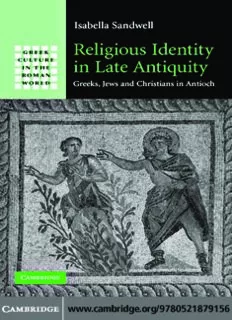
Religious Identity in Late Antiquity: Greeks, Jews and Christians in Antioch (Greek Culture in the Roman World) PDF
Preview Religious Identity in Late Antiquity: Greeks, Jews and Christians in Antioch (Greek Culture in the Roman World)
RELIGIOUS IDENTITY IN LATE ANTIQUITY Studies of religious interaction in the fourth century ad have often assumed that the categories of ‘pagan’, ‘Christian’ and ‘Jew’ can be straightforwardlyapplied,andthatwecanassesstheextentofChris- tianization in the Graeco-Roman period. In contrast, Dr Sandwell tackles the fundamental question of attitudes to religious identity by exploring how the Christian preacher John Chrysostom and the Graeco-RomanoratorLibaniuswroteaboutandunderstoodissuesof religiousallegiance.Bycomparingtheapproachesofthesemen,who werelivingandworkinginAntiochatapproximatelythesametime, shestrivestogetinsidetheprocessofreligiousinteractioninawaynot normally possible due to the dominance of Christian sources. In so doing,shedevelopsnewapproachestothestudyofLibanius’religion, theimpactofJohnChrysostom’spreachingonhisaudiencesandthe importanceofreligiousidentitytofourth-centuryindividuals. Isabella Sandwell is Lecturer in Ancient History at the Uni- versityofBristol. greek culture in the roman world Editors susan e. alcock,UniversityofMichigan jas´ elsner,CorpusChristiCollege,Oxford simon goldhill,UniversityofCambridge The Greek culture of the Roman Empire offers a rich field of study. Extraordi- naryinsightscanbegainedintoprocessesofmulticulturalcontactandexchange, politicalandideologicalconflict,andthecreativityofachanging,polyglotempire. During this period, many fundamental elements of Western society were being set in place: from the rise of Christianity, to an influential system of education, to long-lived artistic canons. This series is the first to focus on the response of Greek culture to its Roman imperial setting as a significant phenomenon in its ownright.Tothisend,itwillpublishoriginalandinnovativeresearchintheart, archaeology,epigraphy,history,philosophy,religion,andliteratureoftheempire, withanemphasisonGreekmaterial. Titlesinseries: AthleticsandLiteratureintheRomanEmpire JasonKo¨nig DescribingGreece:LandscapeandLiteratureinthePeriegesisofPausanias WilliamHutton ReadingtheSelfintheAncientGreekNovel TimWhitmarsh Image,PlaceandPowerintheRomanEmpire:VisualReplicationandUrbanElites JenniferTrimble TheMakingofRomanIndia GrantParker ReligiousIdentityinLateAntiquity:Greeks,JewsandChristiansinAntioch IsabellaSandwell RELIGIOUS IDENTITY IN LATE ANTIQUITY GREEKS, JEWS AND CHRISTIANS IN ANTIOCH BY ISABELLA SANDWELL CAMBRIDGEUNIVERSITYPRESS Cambridge, New York, Melbourne, Madrid, Cape Town, Singapore, São Paulo Cambridge University Press The Edinburgh Building, Cambridge CB28RU, UK Published in the United States of America by Cambridge University Press, New York www.cambridge.org Information on this title: www.cambridge.org/9780521879156 © Isabella Sandwell 2007 This publication is in copyright. Subject to statutory exception and to the provision of relevant collective licensing agreements, no reproduction of any part may take place without the written permission of Cambridge University Press. First published in print format 2007 ISBN-13 978-0-511-34260-8 eBook (NetLibrary) ISBN-10 0-511-34260-8 eBook (NetLibrary) ISBN-13 978-0-521-87915-6 hardback ISBN-10 0-521-87915-9 hardback Cambridge University Press has no responsibility for the persistence or accuracy of urls for external or third-party internet websites referred to in this publication, and does not guarantee that any content on such websites is, or will remain, accurate or appropriate. But as for Christ you love him, you say, and adopt him as the guardian of your city instead of Zeus and the god of Daphne andCalliope. (Julian,Misopogon357c) Contents Preface pageix Listofabbreviations xi part i introduction 1 1 Understandingreligiousidentityinfourth-centuryAntioch 3 2 Imperialsociety,religionandliteraryculturein fourth-centuryAntioch 34 part ii constructed and strategic religious identities and allegiances 61 3 Chrysostomandtheconstructionofreligiousidentities 63 4 Libaniusandthestrategicuseofreligiousallegiance 91 part iii religious identities and other forms of social identification 121 5 ReligiousidentityandothersocialidentitiesinChrysostom 125 6 ReligiousallegianceandothersocialidentitiesinLibanius 154 part iv religious identity and social organization 181 7 ChrysostomandsocialstructureamongChristiansin Antioch 185 8 Libanius,religiousallegianceandsocialstructure 213 vii viii Contents part v assessing the impact of constructions of identity 241 9 Religiousidentity,religiouspracticeandpersonalreligious power 245 10 Conclusion 277 Bibliography 282 Index 308 Preface This book started out as a PhD thesis completed at University College Londonin2001.TheoriginalintentionofthatPhDwastoproduceanew approachtounderstandingreligiousinteractioninthefourthcenturyadby exploringthewritingsofLibaniusandChrysostomalongsideoneanother. Ihopedtogainaccesstoprocessesofreligiousinteractioninawaythatis not usually possible for the ancient world by taking advantage of the fact that these two authors, from different religious traditions, were working andwritinginthecityofAntiochalmostcontemporaneously.Theoriginal project did not get as close to achieving this goal as I would have liked. Four years of post-graduate study was barely enough time to get to grips withthemassivebodyofmaterialprovidedbyLibaniusandChrysostom, letalonetodevelopanewtheoreticalmodelforunderstandingwhattheir writings tell us about religious interaction. When I began to think about turningthePhDintoapublishablebook,itveryquicklybecameclearthat alotmoreworkwasneededinordertomakemystudymatchtheclaims I was making for it. Over the last two years I have been engaged in this work and have tried to develop a strong theoretical grounding for ideas thatpreviouslyhadonlyembryonicform.Thechoicetoalternatechapters onLibaniusandJohnChrysostomhasremained,andchapters5and6in thecurrentbookbearquiteastrongresemblancetochapters1and2inthe originalPhD.Otherwise,thecurrentbookisquitedistinctfromthePhD andhasinvolvedacompletereformulationofmyarguments.Inparticular, my approach to how we use Libanius’ writings on religion is now more sophisticated,asismyapproachtoissuesofreligiousidentity. Thecompletionofthebookwouldnothavebeenpossiblewithoutthe helpofnumerousindividuals.Primarily,IamindebtedtoJohnNorthwho has been with the project from the start as my PhD supervisor. Since the completionofthePhDhehascontinuedtoreaddraftsandofferinvaluable adviceandhasbeenaconstantsourceofencouragement.Hisapproachto the study of ancient religion has had a massive impact on my thinking, ix
Description: